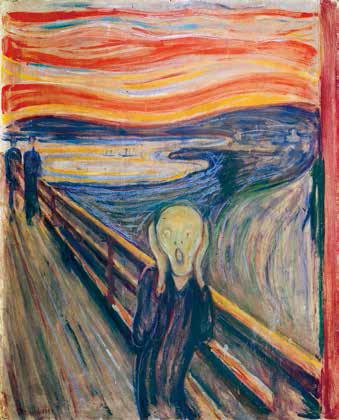Zhejiang Publishes Chinese Edition of Edvard Munch: Complete Paintings
Li Yuehong

《吶喊》蒙克代表作The Scream (left) and Anxiety, two major works by Edvard Munch

《焦虑》蒙克代表作The Scream (left) and Anxiety, two major works by Edvard Munch
Edvard Munch (1863 –1944) was a Norwegian painters and printmaker whose intensely evocative treatment of psychological themes built upon some of the main tenets of late 19th-century Symbolism and greatly influenced German Expressionism in the early 20th century. His best known work is The Scream, painted in 1893.
The autumn of 2019 will see a large-scale exhibition of Munchs works at the National Museum in Beijing and Shanghai Museum. The Munch exhibition will feature roughly 100 works from the Munch Museum collection, including 50 to 60 paintings.
The Chinese-language edition of Edvard Munch: Complete Paintings was launched in October 2018 at the Norwegian Embassy in Beijing. Their Majesties King Harald and Queen Sonja of Norway were in attendance at the launch.
The four-volume book and the two exhibitions are designed to enable Chinese people to better appreciate the art and thought of Edvard Munch.
Before he passed away, the Norwegian artist donated all his artworks, documents, and diaries to the city government of Oslo, making the worlds biggest Munch collection and giving birth to Munch Museum.
The two exhibitions in Beijing and Shanghai in 2019 will be the fourth time Munchs artworks have been exhibited in China. The first exhibition occurred in 1961; the second took place respectively in Beijing, Chengdu and Kunming; the last was in Shanghai in 1997.
The four-volume Chinese-language edition includes all 1,871 paintings by Edvard Munch. The book offers comprehensive and detailed information on each of the paintings based on latest research results by art historians across the world. The catalogue is based on the accumulated research of both Norwegian and international Munch scholars. Essays by leading art historians in each volume make extensive use of the most up-to-date findings and interpretations. Each volume contains a comprehensive index, a bibliography, and a listing of exhibitions. The reader can easily access all technical and artistic information on any painting. This, the first comprehensive study of its kind, provide both scholars and collectors of Edvard Munchs work with an invaluable resource for further research and collecting. All lovers of Munchs art will delight in this unique publication and find in it a source of inspiration and insight.

2 012年“愛德华·蒙克:现代之眼”画展在伦敦举行。图为一名观众和作品《桥上的女孩》。 CFP供图A visitor walks past Girls on the Bridge at an Edvard Munch exhibition in 2012 in London.
The successful launch of the Chinese edition means all the problems in translation solved through hard work. The translation project officially started in 2015. After all other original partners dropped out, Zhejiang Peoples Art Publishing House, a member of the United Publishing Group of Zhejiang, went ahead with the enterprise, determined to produce this finest art book even at the risk of losing money. The translation was based on the English-language edition. The translators ran into difficulties as the English edition contains a great number of words, terms and phrases from the languages of Norway, Germany, France, Denmark, Sweden, and Finland. These words appear in the information on names of places, persons, exhibitions, and museums. Essays and introductions were another source of headache as they teemed with words loaned from above-mentioned languages. The translators sought assistance from Peking University, Beijing Foreign Studies University, China Academy of Art, and Zhejiang University as well as Norwegian Embassy in Beijing. Thanks to the embassy, a national cultural promotion foundation in Norway provided financial support to the Chinese translation project.
In order to assure the quality of the reproduction, the Zhejiang publisher sent a copy of color proof directly to Munch Museum in Norway for ratification. The museum okayed the color proof and thought the color reproduction was even better in some aspects than the Norwegian edition of the book. The museum said it was going to have ten sets of the book in its collection.
Zhejiang has its ties with Munch many more decades ago. Lu Xun wrote 14 short stories based on his memories of his hometown and the people there in his childhood years. He named the collection of the 14 stories 呐喊, which can roughly translated as . The collection is the most famous of the stories the literary master wrote. He appreciated the works of Munch. He mentioned the Norwegian artist in his correspondences. Lu Xun was among the people behind the rise of modern printmaking in China. In the last years of his life, Lu Xun put together a collection of prints made by Munch in the hope of publishing it as a book. The project didnt come to pass as the writer passed away. What Lu Xun wanted to do singlehandedly was now achieved by a publisher in Zhejiang. It is never too late to introduce Edvard Munch to China readers.

